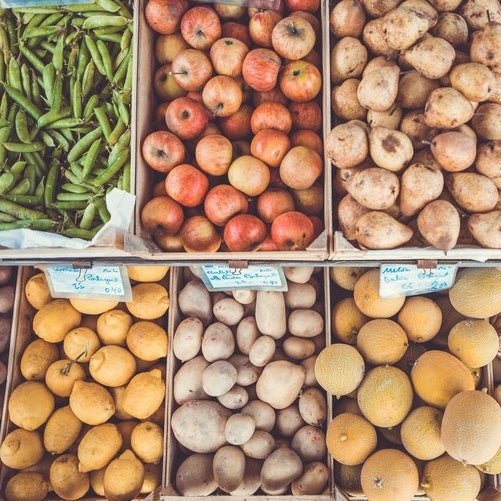Healthy pantry foods to keep your nutrition on track.
Stocking a healthy pantry is the first step to eating right, regularly. With healthy ingredients on hand, you're much more likely to reach for nutritious snacks and prepare meals that pack in plenty of protein, healthy fats, whole grains, fiber, vitamins, minerals, and antioxidants. Keep good-for-you foods at your fingertips to limit the temptation of overly processed junk, have an at-the-ready fix when hunger strikes, and increase your chances of healthy eating success.
OK, you're sold. But how do you go about stocking a healthy pantry? Let us help! We've put together a number of items that should always be on your pantry shelves or in your freezer or fridge. You don't necessarily need every single ingredient we recommend; feel free to adjust according to your personal taste and the snacks and meals you like best. But stock up on a number of the items listed below and you'll be well prepared whenever you want to cook or simply grab a nutritious nibble.
Ready to shop? Here's your healthy pantry list.
HEALTHY PANTRY LIST
Note: You'll notice that we recommend low-sodium varieties of most of the packaged foods on this healthy pantry list. Standard packaged foods tend to contain far too much sodium; instead, purchase low-sodium foods, then add salt to taste to control your sodium intake.
Fresh Produce
Fresh fruits and veggies should have a starring role in every meal you make. Keep a rotating selection of produce on hand. Shop for seasonal produce whatever looks the freshest at the farmer's market or in the produce aisle and adapt your recipes accordingly. Go for variety as well a mix of sweet, tart, tangy, and bitter produce will keep your taste buds happy. Some great options include:
- Leafy greens (leaf lettuce, spinach, kale)
- Carrots
- Cucumbers
- Bell peppers
- Tomatoes
- Avocado
- Beets
- Bananas
- Apples
- Citrus fruits (oranges, grapefruit, lemons, limes)
- Seasonal fruits (berries, melon, peaches, plums)
Nuts, Seeds, & Dried Fruit
Stock up on a variety of nuts, seeds, and dried fruits for high-protein and quick-energy snacks, and to add to oatmeal, pancakes, muffins, salads, and other recipes. Nut butters are full of high-quality protein and healthy fat, perfect for spreading on bread, crackers, rice cakes, and sliced fruits and veggies. Chia and flax seeds are nutrient-dense superfoods that mix well in smoothies and baked goods. Make sure your healthy pantry list includes:
- Natural, no-salt added nut butters
- Nuts raw and/or dry-roasted and unsalted (almonds, walnuts, pecans, hazelnuts, brazil nuts, peanuts, pine nuts, pistachios)
- Seeds (pumpkin, sunflower, chia, flax)
- Dried fruit, no sugar added (raisins, cranberries, cherries, apricots, dates, figs)
- Coconut (shredded or flaked)
Cans & Jars
Dedicate a shelf in your pantry to these basics, which will help create the foundation for numerous sauces, soups, and stews. Canned tuna, salmon, and beans are excellent sources of protein (choose BPA-free cans whenever possible). Applesauce makes a quick snack, and can serve as a natural sweetener in baked goods.
- Low-sodium diced tomatoes, tomato sauce, and tomato paste
- Low-sodium broths (veggie, chicken, beef)
- Lite coconut milk
- White miso
- Tahini
- Canned, no-salt added beans (garbanzo, black, kidney, cannellini, great northern)
- Canned tuna and salmon
- Unsweetened applesauce
Grains & Dry Goods
A variety of flours will serve all your baking needs, plus make it simple to whip up healthy pancakes whenever the craving hits. Whole grains or whole grain pasta form the foundation for many meals. Quinoa takes less than 15 minutes to cook and is a "complete" protein (containing all nine essential amino acids), making it easy to go meatless. Dried lentils cook quickly and are also an excellent source of vegetarian protein.
- Flours (all-purpose, whole wheat, and alternatives for food sensitivities: almond, coconut, rice)
- Whole grains (brown rice, quinoa, bulgur, pearl barley)
- Oats (rolled and steel-cut)
- Cornmeal
- Pasta (whole grain, or alternatives for food sensitivities: quinoa, corn, rice)
- Dried lentils
In the Fridge
Think lean, low fat, and unsweetened when it comes to the basics that fill your fridge. Stick with plain yogurt to avoid added sugar (top with fresh fruit to sweeten the tart taste). Fresh salsa is delicious and nutritious and adds flavor to many meals and snacks. As for cheese, consider fat, sodium, and lactose content when making your selections. Choose hard cheeses (such as Parmesan and Romano) with strong flavors that require only a small amount per recipe. Steer clear of pre-sliced cheese, which may contain additives, and pick aged sharp cheddar or low-fat Swiss for sandwiches and omelets instead. Goat cheese and sheep's milk feta are great alternatives to cow's milk cheese. Cottage cheese and part-skim mozzarella string cheese both make simple, nutritious snacks.
- Lean meat, poultry, and fish
- Water-packed tofu
- Eggs
- Hummus
- Cheeses (Parmesan/Romano, feta, goat, cottage, aged sharp cheddar, low-fat Swiss, part-skim mozzarella string)
- Low-fat milk, or dairy-free alternatives: unsweetened soy, almond, or coconut milk
- Low-fat or non-fat plain Greek yogurt
- Fresh salsa
In the Freezer
While fresh produce is an important component of a healthy pantry, frozen fruits and vegetables also have a place. Frozen produce often contains more nutrients than its fresh counterpart, because it's harvested and frozen at the peak of ripeness and retains its nutrients until used. Frozen fruit will thicken and sweeten a smoothie without watering it down. Thawed or warmed frozen berries make a great topping for hot oatmeal. Frozen vegetables are a fast, prep-free addition to soups, pastas, and stir-fry meals. Freezing lean meat, poultry, and veggie burgers means you'll always have quality protein on hand. And let's not forget treats! We all need sweets, in moderation just make sure your frozen treats are low in fat.
- Frozen fruit (berries, mango, peach slices)
- Frozen vegetables (corn, peas, broccoli, green beans, carrots, edamame)
- Frozen lean ground beef or turkey
- Frozen turkey or veggie burgers
- Turkey or chicken sausage
- Low-fat treats ice cream, frozen yogurt
Bread & Other Carbs
Bread and other carbohydrates often get a bad rap, but healthy carbs are critical for energy. The key is to choose whole-grain carbs to avoid extreme blood sugar highs and lows. Gluten-free options for anyone with an intolerance exist for bread, crackers, tortillas, and wraps, but taste and quality can vary significantly; test a few to discover your favorites, and always read the ingredients to find the healthiest brands. Brown rice cakes are naturally gluten free and form the base for a crunchy snack, spread with nut butter or hummus. Other options to satisfy your crunch cravings include corn tortilla chips (the healthiest chips are baked or cooked in coconut oil) and popcorn (try it topped with a small amount of real butter or olive oil and nutritional yeast).
- Whole grain bread
- Whole grain or sprouted tortillas
- Whole grain crackers
- Brown rice cakes
- Corn tortilla chips (baked or cooked in coconut oil)
- Popcorn
Oils, Vinegars, & Condiments
Good quality extra virgin olive oil is your go-to for low-heat cooking and homemade salad dressing. Coconut and canola oil fill other cooking and baking needs. Sesame oil is great to have on hand for a pungent flavor enhancer. Stock up on a variety of vinegars to use in dressings, sauces, and marinades. Other bottled sauces such as hot sauce and low-sodium soy or soy sauce alternatives add powerful flavor punch to your healthy meals. For ketchup and mustard, look for natural, lower sodium varieties. If mayo is a must, choose the heart-healthy mayo alternative Vegenaise.
- Oils (extra virgin olive, coconut, canola, sesame)
- Vinegars (balsamic, red wine, white wine, rice, apple cider)
- Low-sodium soy sauce, tamari, or Bragg's Liquid Aminos
- Hot sauce (Cholula, Sriracha)
- Dijon mustard
- Natural ketchup
- Vegenaise
Herbs, Spices, & Sweeteners
Keep several herbs, spices, and sweeteners in your kitchen to add flavor oomph to healthy foods. Fresh herbs can ratchet up the flavor of any salad or sauce; fresh garlic is a must for most cooked meals, plus it gives your immune system a boost; and fresh ginger packs incredible flavor while helping to soothe any stomach distress. A solid collection of dried herbs and spices is also essential for any home chef. Table salt works for basic cooking, but other salt options like sea, kosher, and Himalayan add a better burst of flavor when sprinkled atop food. On the sweet side, regular granulated sugar is sometimes required, but natural sweeteners like honey, agave, and pure maple syrup can often be used in its place. Cocoa powder and dark chocolate chips come in handy for baking and pancake batter.
- Fresh garlic
- Fresh ginger
- Herbs (various fresh and dried)
- Pepper (black, red chile flakes)
- Salt (table, sea, kosher, Himalayan)
- Sugar (granulated, brown)
- Honey
- Agave
- Pure maple syrup
- Unsweetened cocoa powder
- Dark chocolate chips
Supplements
Protein powders and supplements certainly have a place in your healthy pantry. To mix the smoothest possible protein shakes, choose a BlenderBottle brand shaker with our patented BlenderBall wire whisk.
Getting a handle on good nutrition is actually quite easy with some advance planning to make sure you have wholesome, delicious ingredients at the ready. Bon appetit!





Leave a comment
All comments are moderated before being published.
This site is protected by reCAPTCHA and the Google Privacy Policy and Terms of Service apply.